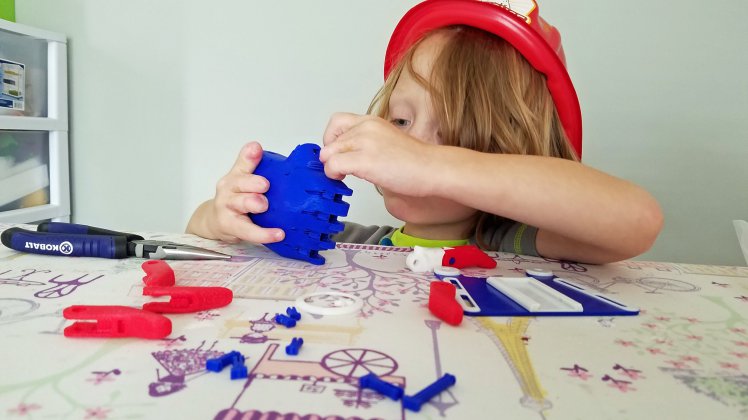How do you make a radio with no batteries, power source, or electronics expertise? What does levitation have to do with 3D printing? And what’s all the excitement adidas’ new limited edition running shoe range about?
This edition of our 3D printing news digest, Sliced features the latest stories from adidas, Android, Ultimaker, Carbon, Continental, EOS, Occipital, University of Ottawa, Carnegie Mellon University, Futurecraft 4D, Structur3D Printing, NorDan, BLB Industries, Tomsk State University and The Red Dot Design Museum.
Business is big for EOS and Ultimaker
Automotive manufacturing company Continental has invested in several EOS M 290 metal 3D printers. The company will use the metal 3D printers to produce metal components in series and will be provided with assistance from EOS for installation and training. The news adds to the growing trend of additive manufacturing for end use production that our recent series examined in detail.
Structur3D Printing has announced that UltimakerGB is now a global reseller of the Discov3ry Complete paste extrusion system.
And 3D printer manufacturer BLB industries is in the process of building a machine for fittings company NorDan AB. The company will use the 3D printer and its 5.625 cubic meter build volume to 3D print doors and windows.
Red Dot designs and adidas hypebeasts
Design consultancy, Red Dot has opened the Red Dot Design Museum, an exhibition space for creative and applied design, at a new location in Singapore’s Marina Bay.
The Red Dot Design Awards are presented each year, with the 2017 prize going to Maria Alejandra Mora-Sanchez for a 3D printed Loom dress, and its 2016 prize to Spanish firm Xkelet for its 3D printed arm casts.
In 3D printing news that will excite “hypebeasts” and “hypebaes” everywhere, adidas is set to release its Futurecraft 4D footwear in New York on 18 January.
The Futurecraft 4D is the first running shoe with midsoles manufactured using Continuous Light Interface Production (CLIP) technology from 3D printing company Carbon.
Adidas, like other footwear manufacturers, has increasingly used the illusion of scarcity as a marketing tool. While the Futurecraft 4D shoes will initially retail for $300, it is likely that the resellers will be charging upwards of $1000 on the 2nd hand market. The hype surrounding the shoes then translates into increased demand for the next “drop” from manufacturers.

Occipital opts for 3D sensing, Android does not
Digital hardware company Occipital demonstrated its Structure depth sensor at CES 2018. The mobile depth sensor can fit onto the back of an iPad and capture a 3D model of objects in front of it and rooms ahead. These may then be accessed via Occipital’s Canvas iOS app.
And a report by Digitimes has claimed that many China-based Android smartphone manufacturers, especially those launching products in 2018, will not be incorporating 3D sensing technology due to technological and cost barriers. The companies will instead channel AI efforts into voice interface, video recording and IoT applications.
3D Printing Industry reported in November 2017 that the iPhone X’s face security software, a 3D sensing technology called Face ID, was defeated by a mask manufactured by Vietnamese tech security firm Bkav.
Groundbreaking research at Tomsk State, Carnegie Mellon and Ottawa
Scientists from Russia’s Tomsk State University are developing a new 3D printing method involving levitation. Foam plastic particles are suspended in an acoustic ultrasonic wave stream, where they can be controlled and deposited. The researchers hope to make the technology available by 2020. As previously reported by 3D Printing Industry, researchers at Bristol have used 3D printing to make a portable tractor beam.
3D printer manufacturer Optomec’s Aerosol Jet Technology is being used by Carnegie Mellon University (CMU) to research the 3D printing of electronics. Specifically conformal sensors, low loss passives and antennas for on-chip and off-chip electronics.
CMU Dr Rahul Panat, additive manufacturing project lead said,
“we employ an Optomec Aerosol Jet 3D print system to directly print nanoparticle inks and polymers over complex surfaces…”
Panat added that “the Aerosol Jet system has enabled us to fully print 3D antennas at the sub-100 micrometer length scale and to conduct simulation studies to identify omnidirectional antenna designs.”
And the Learning Crossroads (Carrefour des Apprentissages) building, a new interdisciplinary student space at the University of Ottawa, has unofficially opened and is expected to open fully within the next eight weeks. The building notably features VR and 3D printing facilities alongside a dedicated data visualization room.

Innovative makers in Texas and North Carolina
Five-year-old Cameron Haight from Charlotte, NC, has designed and created artificial hands for children with limb differences, even adding some special holders for nerf guns, kitchen utensils and pencils. Haight was born with Amniotic Band Syndrome which caused a defect in his hands. The 3D printed hands he received inspired him to print hands for others.
And finally, Houston, Texas-based practitioner Sage Hansen has created a functional 3D printed radio with a crystal radio receiver, which works without batteries or a mains power supply. Hansen has also uploaded instructions and STL files so others can make the radio.

Make your nominations for the 3D Printing Industry Awards 2018 now.
For the latest updates on 3D printing across the world, subscribe to our free 3D Printing Industry newsletter, follow us on Twitter, and like us on Facebook.
Featured image shows the Futurecraft 4D sole in a Carbon 3D printer. Photo via adidas.

